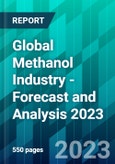The global methanol industry occupies a pivotal role across multiple sectors, serving as a crucial building block for an array of chemical and fuel products. Methanol, characterized by its versatility and cost-effectiveness, with the chemical formula CH3OH, finds its origins in diverse feedstocks such as natural gas, coal, and biomass. Applications span a wide spectrum from chemicals and plastics manufacturing to energy production and transportation fuels.
As of September 2021, the global methanol production capacity was estimated at approximately 120 million metric tons annually, while the market size ranged between $20 to $30 billion USD. Notably, China emerges as the foremost producer and consumer, holding a substantial portion of global production capacity, closely intertwining its methanol industry with chemical manufacturing and energy sectors. Other significant methanol-producing nations encompass the United States, Iran, Saudi Arabia, and Russia.
The methanol industry finds applications in multiple sectors: in the chemical industry, it serves as a fundamental feedstock for an array of chemicals such as formaldehyde, acetic acid, and methyl tert-butyl ether (MTBE), with utility across plastics, textiles, paints, and adhesives. Additionally, its relevance extends to energy and transportation sectors, with applications as an alternative fuel or fuel additive. This extends to processes like methanol-to-gasoline (MTG) and methanol-to-olefins (MTO), indicating its potential within the broader context of synthetic fuels. Moreover, the potential of methanol as an alternative, renewable energy source draws attention. Processes capable of producing methanol from renewable sources like biomass or captured carbon dioxide hold promise in terms of environmental sustainability.
At the same time, the market trends and driving forces behind the methanol industry are noteworthy. The increasing demand for petrochemical goods, coupled with the quest for cleaner energy sources, contributes to the surge in methanol demand. Moreover, methanol's potential role as a hydrogen carrier within energy storage and transportation systems has generated interest, particularly in the context of shifting towards renewable energy sources. Ongoing research and development endeavors are dedicated to enhancing methanol production process efficiency and exploring sustainable feedstock options, aimed at reducing the environmental footprint associated with production.
The report titled Global Methanol Industry - Forecast and Analysis 2023 offers an in-depth exploration of the dynamic landscape of the methanol industry, providing a comprehensive overview of key regions, trends, players, and market forces. This comprehensive analysis spans various geographical segments, including Asia Pacific, Europe, Middle East and Africa, North America, and South America.
The report unfolds across seven extensive sections, starting with an introduction to the global methanol industry. It delves into the core understanding of methanol, its multifaceted applications, and the entire value chain analysis. The discussion extends to the emergence of a methanol economy, followed by an exploration of safety concerns associated with methanol.
The global perspective of the methanol industry is illuminated through its geographical and sector-wise demand and production statistics. A meticulous regional demand analysis dissects the nuanced dynamics across key regions, while a granular sector-wise consumption overview provides insights into its diverse applications.
The pricing models that influence the global methanol market are dissected, providing a holistic view of the market's financial underpinnings. The report also delves into the impacts that shape the industry, addressing both driving factors and challenges. Industry trends are meticulously examined to provide readers with an insightful foresight.
The report employs a SWOT framework to analyze the global methanol industry, illuminating its strengths, weaknesses, opportunities, and threats. Porter's Five Forces Strategy Analysis assesses the industry's competitive dynamics, encapsulating aspects such as buyer and supplier power, rivalry, new entrant threats, and substitutes.
The report also provides an in-depth understanding of the competitive landscape by presenting a comprehensive analysis of major industry players. These include global giants such as BASF SE, BP Plc, Saudi Basic Industries Corporation (SABIC), and many more.
The study offers a comprehensive and holistic examination of the industry's present status, future trajectory, and the forces shaping it. The report equips industry stakeholders, researchers, and decision-makers with a panoramic view to understand, strategize, and navigate the intricate realm of the global methanol industry.
Table of Contents
Executive SummarySection 1: Global Methanol Industry
Companies Mentioned
- BASF SE
- BP Plc
- China National Coal Group Corporation
- China Risun Coal Chemical Limited
- Deepak Fertilizers and Petrochemicals Corporation
- Duke Energy Corporation
- Eastman Chemical Company
- Gujarat Narmada Valley Fertilizers
- JSC Togliattiazot
- Linde Plc
- LyondellBasell Industries
- Mitsubishi Gas Chemical Co. Inc.
- Petroleos Mexicanos (Pemex)
- Petroliam Nasional Bhd (PETRONAS)
- Rashtriya Chemicals and Fertilizers Limited
- Repsol SA
- Saudi Basic Industries Corporation (SABIC)
- Shell Plc
- Terra Industries Inc/CF Industries
- TotalEnergies SE
- Yunnan Ruiqi Chemical Company








